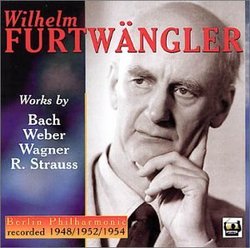| All Artists: Bach, Weber, R. Strauss, Wagner Title: Works by Bach Weber Wagner R. Strauss Members Wishing: 1 Total Copies: 0 Label: Harmonia Mundi USA Original Release Date: 1/1/1948 Re-Release Date: 1/9/2001 Album Type: Import Genre: Classical Styles: Opera & Classical Vocal, Forms & Genres, Suites, Theatrical, Incidental & Program Music, Historical Periods, Baroque (c.1600-1750), Modern, 20th, & 21st Century Number of Discs: 1 SwapaCD Credits: 1 UPC: 713746193928 |
Search - Bach, Weber, R. Strauss :: Works by Bach Weber Wagner R. Strauss
 | Bach, Weber, R. Strauss Works by Bach Weber Wagner R. Strauss Genre: Classical
|
Larger Image |
CD Details |
CD ReviewsWF in Classic Performances and Good Sound Thomas F. Bertonneau | Oswego, NY United States | 10/18/2000 (4 out of 5 stars) "Wilhelm Furtwängler's (1886-1954) way with Bach will inevitably disturb those of the purist camp. Furtwängler utilizes a symphonic complement of strings, introduces crescendi and diminuendi that the politically correct version of baroque music abjures, and overall exercises a Romantic conception of the music. Yet as Leopold Stokowski discovered, and as young conductors of the reigning generation such as Esa-Pekka Salonen are rediscovering, the symphonic treatment conveys Bach's counterpoint, his long interweaving lines, much the way a great organ would, and with complete legitimacy. From Furtwängler's 24 October 1948 concert with the Vienna Philharmonic, captured on magnetic tape for rebroadcast, we hear Bach's Suite No. 3. The Overture, which takes the form of a Prelude and Fugue, is grand; the dance-movements lively. True, Furtwängler sees Bach through the prism of Brahms, Bruckner, and Richard Strauss (the latter of whom he insisted was a "baroque composer"); but Bach has always spoken to the momwnt through the tradition that he established. Weber's "Freischütz" Overture again, under Furtwängler (this time from 8 December 1952), receives a broad treatment, certainly not the kind that it would get, say from Sir Roger Norrington. Wagner's "Ride of the Valkyries" (31 March 1949) benefits from a good recording. The Strauss "Don Juan" (27 April 1954) is just as good as Tahra's advertisements claim, in high fiedlity, suavely taken, grand, powerful. For those who feel curiosity about Furtwängler but worry about the acoustic limitations of pre-stereophonic recording, this disc might well be the best introduction."
|

 Track Listings (8) - Disc #1
Track Listings (8) - Disc #1